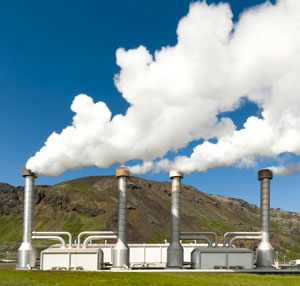
Geothermal power plant in Iceland
�The promise of low-impact, renewable energy that is always on tap continues to drive geothermal energy research, and Mines faculty and students are hot on the trail.
For most, the term ‘renewable energy’ conjures images of towering wind turbines, massive hydroelectric dams and rooftops glistening with solar panels. But to an increasing number of researchers, students and engineers at Mines and around the world, there’s another oft-overlooked resource: the heat beneath our feet.
“People know they can get hot water from the earth, but they have no idea how comprehensive this resource can be,” says Masami Nakagawa, an associate professor in the Department?of Mining Engineering, who has been working with researchers on and off campus reviving interest and research in this long-neglected resource.
Over the last three years, he?has won Department of Energy ?grants for geothermal research?totaling $1.5 million, some of ?which funded the creation of Mines’ Geothermal Academy, a national hub for research, data collection, education and public awareness efforts.
He has visited a dozen mountain communities to conduct workshops on how heat from the earth could be tapped to produce electricity, heat buildings, warm greenhouses and ?melt lingering snow. In May 2011, the school teamed up with the National Renewable Energy Laboratory (where Nakagawa held a joint appointment) to host the fourth-annual Geothermal Symposium on campus, which included attendees from Japan and New Zealand.
As the federal government grows increasingly interested in geothermal technology, and several communities across Colorado explore sites for what could be the state’s first geothermal power plant, Mines is playing an important role.
“In order to make a geothermal project possible, you need geologists, geophysicists, reservoir engineers, rock mechanics specialists, power plant and environmental engineers, and somebody who is familiar with policies. On this campus, we have people in all these areas,” says Nakagawa, who is teaching an introduction to geothermal class this fall for the third time, and hopes to develop a geothermal research center, as well as an interdisciplinary master’s degree program at Mines.
What is ‘geothermal’?
Depending on how far down it comes from, the word can mean different things. Geothermal energy can be as low-impact as using existing heat just a few feet below the Earth’s surface, or as invasive as drilling down miles to create a network of energy-generating steam channels.
Perhaps the most common geothermal energy technology in use today is ground source heat pumps (GSHP), which tap the constant year-round 45-60 degree Fahrenheit temperatures, found at depths of just 5 to 10 feet in most temperate regions. Equipped with hundreds of yards of buried, liquid-filled tubes, these systems use basic refrigeration technology to source thermal energy in the ground during winter and shed it there during the heat of summer. Temperatures underground are generally closer to room temperature, so electricity consumption for year-round heating and cooling can be as much as 70 percent lower. About 1 million buildings in the United States currently use GSHP technology, says Nakagawa, including the Colorado State Capitol, where the Geothermal Academy monitors system performance, and the new IKEA retail store in Centennial, Colo.
“It is the most efficient way to heat and cool buildings available,” says Tom Williams, laboratory program manager for geothermal technologies at NREL, which is working closely with Mines to collect long-term data on GSHPs. “It’s a near-term, cost-effective technology with many applications in Colorado.”
Interestingly, at such shallow depths, the relative warmth has almost nothing to do with heat conducted from inside the earth, it’s a factor of average air temperatures on the surface. To tap the earth’s internal heat requires either just the right geography, such as natural hot springs nearby, or some very deep wells.
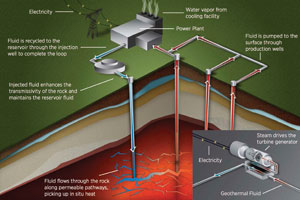
Enhanced geothermal systems, still primarily in the research phase, make use of the Earth’s heat by drilling several miles into the surface, fracturing the rock bed with injected fluid, and then extracting the heated liquid or steam through production wells.
Enhanced geothermal
Enhanced Geothermal Systems (EGS) involve drilling several miles deep into hot, dry basement rock. Hydro-shearing, a process that is analogous but not the same as conventional ?rock fracturing, is performed by pumping fluids in at extremely high pressure, creating a network of fine fissures that extend far beyond the well bore. Fluids pumped into the system pick up energy from the surrounding rock, which can be tapped by production wells intersecting the system. In the case of water, production wells would vent steam, which can be used to drive traditional turbines, then condensed, and pumped back into the injection well in a closed-loop system.
Nakagawa explains that, in theory, opportunities to generate electricity using EGS technology are widespread. “No matter where you are on this continent, if you can drill 5 to 10 kilometers deep, you can get a very high quality of heat,” he says. One 2006 MIT study led by Jeffrey Tester and sponsored by the Department of Energy estimates that EGS could yield 2,000 times the nation’s 2005 electical consumption, in theory.
In reality, the technology is in its infancy, with one pilot plant operating in Soultz, France, and a small commercial plant operating in Landau, Germany. But exploration is under way across the globe, with a company called Geodynamics in Queensland, Australia, planning to drill as many as 90 wells in the coming decade, according to a recent story in The Economist. Worldwide, according to the DOE, untapped geothermal resources contain 50,000 times the energy of all oil and gas resources on the planet.
Technological and economic challenges abound when?it comes to safely and effectively drilling and fracturing?rock miles below the earth. While concerns about induced seismicity seem to be overblown, there’s a lot of science? to conduct and numerous engineering problems to resolve before power companies are willing to put their shareholders’ assets on the line.
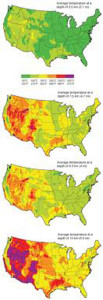 With $1.5 million in DOE grant money, Mines researchers are currently developing computer models that can be used in EGS planning and design. Google recently invested $10 million in EGS research specifically to help companies and universities research ways to improve deep hard-rock drilling techniques and better assess the country’s geothermal resources. “EGS is the holy grail,” says Williams. “Everyone is doing research on it, but we don’t have all the pieces in place yet.”
With $1.5 million in DOE grant money, Mines researchers are currently developing computer models that can be used in EGS planning and design. Google recently invested $10 million in EGS research specifically to help companies and universities research ways to improve deep hard-rock drilling techniques and better assess the country’s geothermal resources. “EGS is the holy grail,” says Williams. “Everyone is doing research on it, but we don’t have all the pieces in place yet.”
In the meantime, existing geothermal reservoirs at more easily accessible depths are already providing clean, 24/7 electricity to communities across the western states, and many believe Colorado should be next.
The revival of geothermal power
According to the Geothermal Energy Association, conventional geothermal plants (which use rising steam or hot water from underground sources to produce electricity) already produce 3,102 megawatts of power in nine states, or enough to power roughly 3 million homes. The vast majority was built in the 1970s and ’80s in California, Nevada and Utah, when soaring oil prices prompted a surge in investment in renewable energy. Today, The Geysers, a 45-square-mile collection of geothermal energy plants north of San Francisco, produces 725 megawatts of electricity. And the Caithness Dixie Valley Geothermal Power Plant, built in 1988 and still Nevada’s largest, produces 66 megawatts. But as oil prices declined, so did interest in geothermal energy.
By 2007, geothermal energy accounted?for just 4 percent of renewable-energy-based electricity in the United States, according to the GEA, and a minute? fraction of overall? energy consumption. ?But in recent years, ?thanks to concern ?about global warming,? carbon emissions and ?skyrocketing energy? prices, geothermal has enjoyed a renaissance.
“What makes it stand out among renewable energy technologies is that it operates around the clock. It is not tied to when the sun is out or the wind is blowing,” says Williams. In 2009, as part of the federal economic stimulus package, the DOE funded $338 million in grants for 129 geothermal energy projects in 39 states: $18 million went to Colorado and $3 million went to Mines to, among other things, explore drilling methods, create models of how to inject fluids into rock and develop technologies for tracking subterranean water flow.
According to the GEA, 772 megawatts of new geothermal capacity is expected to come online in a few years, some of it in Colorado. To help make that happen, the Governor’s Energy Office appointed a Geothermal Working Group, which held a series of meetings over the summer to discuss where to drill exploratory wells and how to pay for them.
“Colorado has the fourth-highest average heat flow per acre in the United States,” says mining geologist Fred Henderson, founder of Mt. Princeton Geothermal. “There is a lot of potential here.”
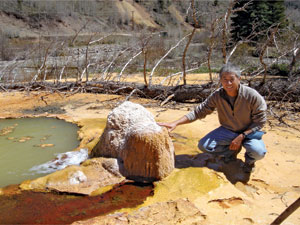
Masami Nakagawa is working with researchers on and off campus to revive interest and research in harnessing geothermal energy production.
�From Mount Princeton to the town of Rico
When in 2008, Henderson proposed developing a 10-megawatt geothermal power plant in the Upper Arkansas Basin near Mount Princeton (home of the hottest springs in the state), Mines geophysics professors Mike Batzle and Andre Revil were among the first to be called in.
“It can cost millions of dollars to drill a single well, so before you do it, you really need to understand the plumbing system below,” explains Revil.
To do that, they have returned every summer with students for month-long field camps on how to use seismic and geophysical techniques for underground mapping. Batzle’s team used a massive hydraulic hammer to produce sound waves below, and then tracked their movement to map the structure of the underground plumbing. Revil and his students then laid hundreds of yards of specialized cable on the surface, using electromagnetic mapping techniques that he developed to trace the movement and pressure of water thousands of feet below.
The project was not without opposition. Hundreds of residents, concerned about how such a plant would impact their wells and the local tourist-driven economy, turned out at Nathrop town meetings to protest. At one point some Mines equipment was destroyed. Thanks to lingering dissent and a series of regulatory hang-ups involving public lands, the project has largely stalled.
Henderson is optimistic that ultimately the differences will be sorted out, and geothermal energy will come to the Upper Arkansas (he is currently looking at another site at Poncha Springs). But Revil, who prefers to stay clear of the politics, says the greatest value of such projects is to give Mines students hands-on experience in working with geothermal systems.
“Our primary goal there was to do good science and provide a good education for our students,” says Revil, who took students to a potential site in Oregon this summer to do similar work. Meanwhile, having learned about the potential of geothermal from Nakagawa’s visits, residents of the tiny former mining town of Rico (population 300) near Telluride are beginning to explore a comprehensive geothermal plan of their own, in the hope that it could not only decrease their reliance on coal-based electricity, but also ease their heating bills and help them grow food in winter.
“Masami is one of the more visionary people I have met in my life. Not only does he grasp the engineering side of things, he understands the human components and that has allowed us to develop a great relationship with Mines,” says Rico resident Rebecca Levy, now a self-proclaimed ‘geothermal advocate’ who visits other communities, touting the promise of geothermal technology.
Both Levy and Nakagawa concede it could be years before a geothermal system is in place in Rico, but already Mines students are there, taking measurements.
“You could generate electricity, and use the spent hot water to heat the school house or town hall, melt snow, or help produce local vegetables in the greenhouse,” says Nakagawa. “This could be a national model for the broad potential of geothermal.”
That could happen if the current swell of interest in geothermal remains hot

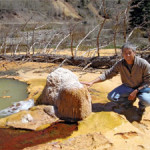

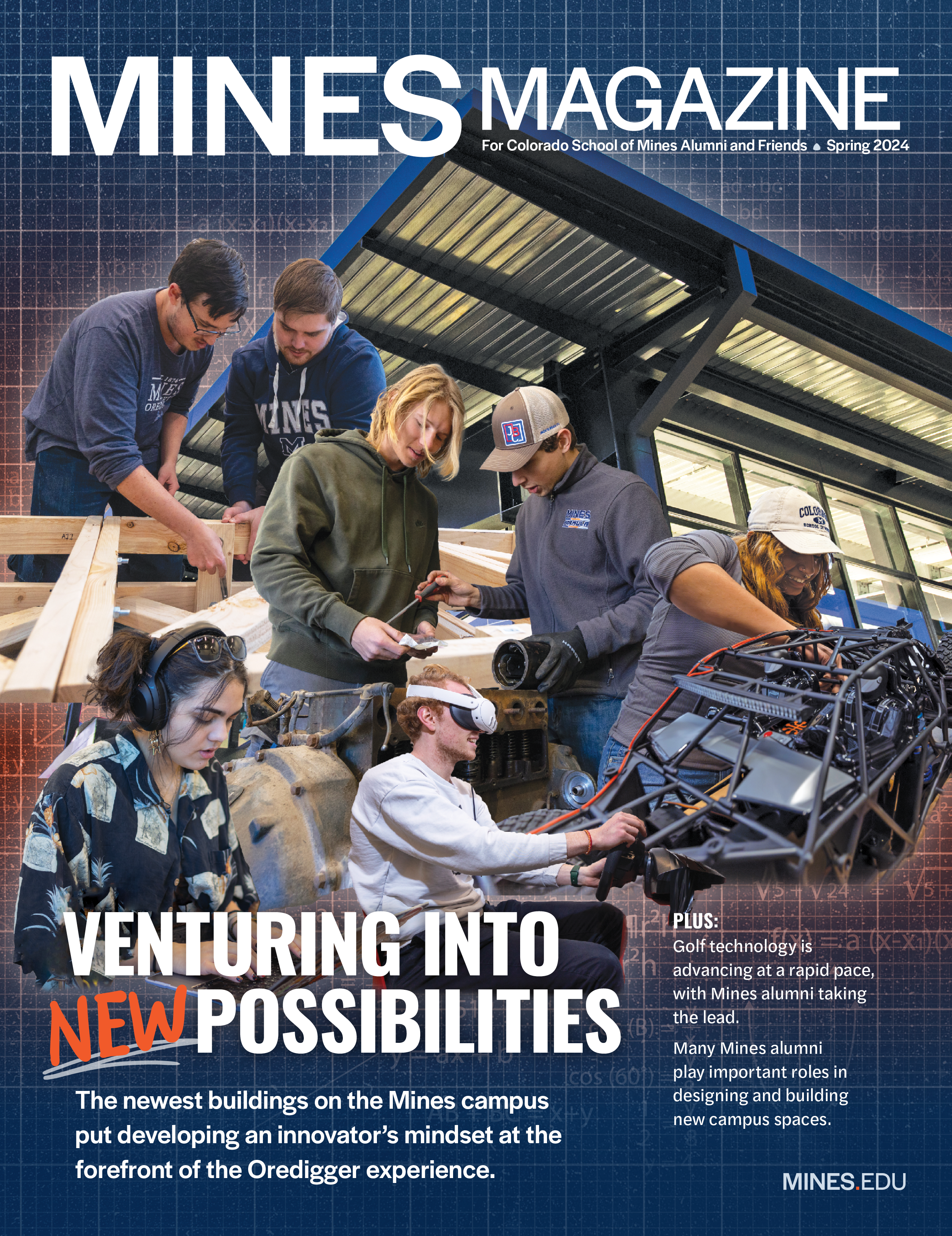
Comments from Claude B. Jenkins ’52, (received via email and posted by Mines magazine)
In 1977, I was transferred from managing Aminoil’s operation(1000 employees running exploration, production,refinery etc.) in the Neutral Zone(between Kuwait and Saudi Arabia) to run Aminoil’s operations in their geothermal operations in the Geysers Field(in a relatively deserted mountain area about 60 miles northeast of San Francisco). At that time, enough wells had been drilled to supply steam to fuel a 136,000 KWH plant owned by P G & E. Aminoil had been contracted to supply the steam to that plant. However, the gov’t regulators would not allow Aminoil to furnish the steam unless we were able to shut in all the wells within several minutes after PG&E had shut down their plant. The common practice at that time for other operators in the field was to send out their employees to each well to manually shut in the wells to avoid sending steam into the atmosphere( said steam containing only minute quantities of H2S) and the wells being over 15 miles from any civilization. The shutdown required probably an hour or so under those conditions. Since manually shutting down the field was not practical(requiring manpower 24 hr/day at each well 7 days/wk etc.). The only feasable option for us was to automate the field so that all field operations(opening,altering,closing valves) could be done from a single computer control center. This of course caused us to be significantly over budget but appeared to be the only alternative. However, that allowed us to go onstream and to proceed with the development of 2 more units – both units with the then standard size of 110,000 KWH in the Geysers. During my 3 years there we only drilled one exploratory geothermal well in Nevada but it was not commercially productive. Didn’t cost us any money as we were able to get 50% of the cost paid for by the government and sold a 49% interest to a third party for 50% of the cost. As the gov’t did not receive any proprietary interest, we had a free ride for our 50% interest.